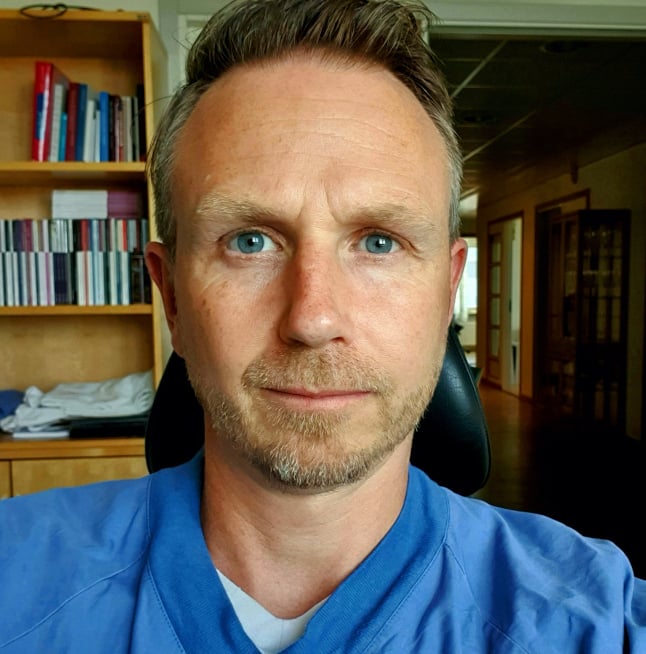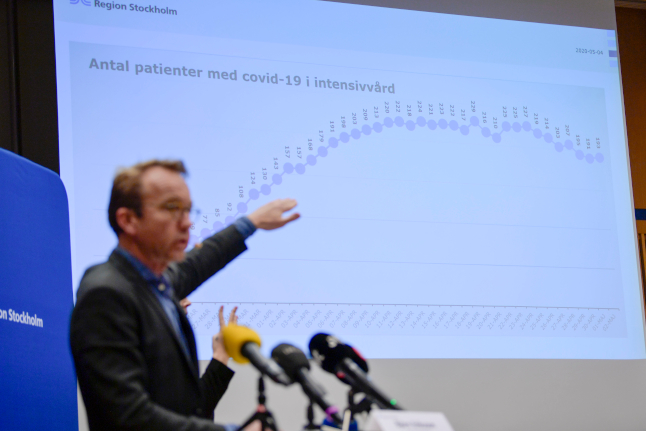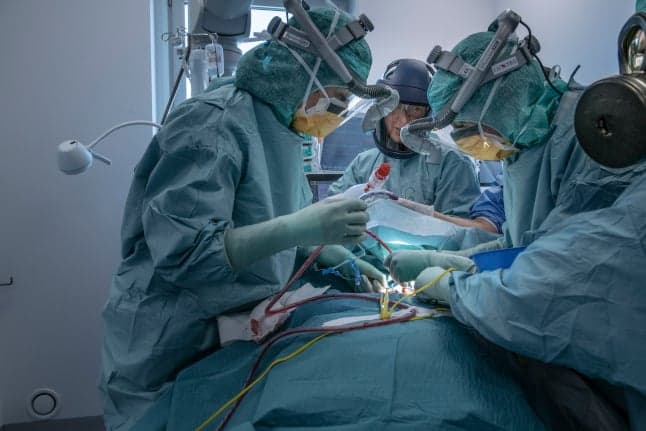Björn Persson is the head of intensive care and thoracic surgery at Karolinska University Hospital in Stockholm. He remembers that the first meeting he attended to discuss the coronavirus with fellow hospital managers took place on January 29th – two days before Sweden reported its first case.
"The virus seemed serious, but we knew very little, and we thought it would more or less stay in China. But we felt that we needed to keep an eye on the situation, so after that we had weekly meetings. Then as you know it slowly started creeping closer and closer," he tells The Local.
Hospital chiefs started planning ahead early on, initially expecting to receive around 10 'extra' intensive care patients – a situation similar to the swine flu in 2009, which was considered a lot at the time. But then the virus forcefully hit Italy, and they realised they would quickly have to reassess their plans.
"We then understood how serious it was, that those early plans we had would not be enough, but that we needed to make huge decisions and make major, major changes," says Persson.

Björn Persson, head of intensive care and thoracic surgery at Karolinska University Hospital. Photo: Private
They did make radical changes, and quickly. On February 7th, Stockholm health chiefs assembled their extraordinary regional crisis management response team. On February 27th, the region confirmed its first infection. In the last week of February, thousands of Stockholmers travelled abroad for spring break – by chance right when the virus started to seriously take hold in parts of Europe – and that's when it really took off.
"The need for hospital care started increasing in early March. By mid-March we started getting deaths," Stockholm healthcare director Björn Eriksson tells The Local three months later.
"After that, it was like an explosion," says Eriksson.
Stockholm normally has around 90 intensive care beds. Authorities would quadruple that figure.
!function(){"use strict";window.addEventListener("message",(function(a){if(void 0!==a.data["datawrapper-height"])for(var e in a.data["datawrapper-height"]){var t=document.getElementById("datawrapper-chart-"+e)||document.querySelector("iframe[src*='"+e+"']");t&&(t.style.height=a.data["datawrapper-height"][e]+"px")}}))}();
It is difficult to compare intensive care capacity between countries, because the exact definition varies even between individual hospitals.
Some distinguish between intensive care and intermediate care, some do not. The Swedish Intensive Care Register describes it as "a level of care that involves close monitoring and advanced treatment of critically ill patients". The patients often need machines to keep their organs from failing; some hospitals in Sweden classified coronavirus care as intensive if a ventilator was involved.
According to figures shared in Swedish media, Sweden had 526 available intensive care beds at the start of the crisis – among the lowest number in Europe (a comparison from 2011 estimated Sweden's intensive care beds at 5.8 per 100,000 people, compared to a European average of 11.5).
In just a matter of weeks, it scaled up to more than 1,100 available beds, which were all equipped to be able to accept patients.
Karolinska is the biggest hospital in the capital region of Stockholm and was given special orders to scale up capacity significantly, and it did, increasing the number of available intensive care beds from 38 to 200.
But while the situation was always serious, it could have been much, much worse. Sweden's stated aim was to keep flattening the curve so that healthcare was not overwhelmed – and while its other aim to protect the elderly failed, with more than 5,000 deaths, this one did work out as planned, at least on paper. At Karolinska, they had around 140 corona patients in intensive care at the peak of the crisis, with spare beds to take in more.
"We received one prognosis in March that suggested we would need up to 1,000 intensive care beds in Stockholm. That would have been... horrible. I don't know if we would have managed," says Karolinska's intensive care chief Persson.
How Karolinska University Hospital increased its intensive care beds:
Karolinska University Hospital: How it increased intensive care capacity
- Space: Karolinska increased the number of intensive care beds in existing units and opened up postoperative wards, where patients normally recover after surgery, to corona patients. These rooms are larger than a normal intensive care room which means one team can get a better overview and look after more patients at the same time.
- Equipment: They ordered new equipment, but also had to scramble to retrieve old ventilators from the basement and the National Board of Health and Welfare's emergency reserves, which were modern 20 years ago but were still functional. They used anaesthetic machines, which are the kinds of ventilators normally used during surgery, and they borrowed ventilators from private care-givers. The next step would have been to borrow ventilators from veterinary clinics, but this was never needed.
- Staff: They scrapped all non-essential administrative work for staff so that they would have more time to look after patients. They drafted in volunteers, staff from other regions in Sweden that were less affected by the outbreak, and staff from private care-givers in Stockholm, and non-urgent surgeries were cancelled which enabled them to transfer other hospital staff to intensive care.
While Karolinska had managed to plan ahead and was ready to face the large influx of patients when they arrived, another much smaller hospital less than two hours away, was caught almost entirely by surprise.
"The Public Health Agency had a prognosis for how many intensive care patients each region could expect, and we were told in the early days that Sörmland should prepare for around 30 patients in total," says Karin Frisell, chief physician for intensive care at the Mälarsjukhuset hospital in the Sörmland region, south-west of Stockholm. "Our infectious disease clinic thought we'd have around three patients at a time in intensive care."
Instead, the hospital has to date treated 87 corona patients in intensive care.
While Sweden's initial focus was to test and trace confirmed patients returning from hotbeds such as Italy, the virus is now believed to have spread under the radar in Sweden after being brought back from travellers returning from many other countries.
That's what happened in Sörmland. On March 11th, the first coronavirus patient was admitted to the intensive care ward at Mälarsjukhuset. Then there was another. And another.
"We were convinced, perhaps somewhat naively, that they would come to us via the infectious disease clinic which had happened in other parts of Sweden. That's what we had planned for. But our first patient came to us from the heart clinic with heart failure, and only tested positive for Covid after X-rays made us suspect that they had the virus," Frisell tells The Local. "And then the patients started pouring in."
How Mälarsjukhuset Hospital increased its intensive care beds:
Mälarsjukhuset: How it increased intensive care capacity
- Space: Most intensive care rooms only have space for one or two patients, so they opened up a new intensive care unit in the postoperative room which had space for 14 beds, which meant they could get a better overview of patients. They also opened a new unit in the cardiology department where cardiology nurses were able to help look after patients.
- Equipment: They received old ventilators from the National Board of Health and Welfare's reserves, and were able to use anaesthetic machines. They also tried to order new equipment, which was difficult. Five new ventilators ordered from the UK never arrived after the UK banned exports, another ten ventilators got stuck in France for several weeks before they arrived. Twenty-five new intensive care beds turned out not to meet the necessary standard and had to be sent back.
- Staff: They more or less had to work with the staff they already had in the hospital, but some retired staff and staff from other parts of the hospital were able to help out. Mälardalen intensive care is a small clinic which made it easier to motivate staff because they all know each other well. They appointed one 'helicopter person' (a role shared by Frisell and two colleagues) who did not treat patients but organised all care and staff rotas from a situation room to maximise efficiency.
Quiz Maker - powered by Riddle
Sweden's National Board of Health and Welfare organised coronavirus care on a national level, but much of healthcare is run regionally with a lot of collaboration between regions. On the whole, the country managed to scale up to the degree that it always had around 20-30 percent spare capacity in intensive care. But that does not reveal the whole picture. Some individual hospitals, like Mälarsjukhuset, were often at maximum capacity.
"We had more than 25 patients in intensive care at one time at the most, and then we had to send them to other hospitals," says Frisell. "There was one day when we had to send five patients to other hospitals, because we had no capacity. It is insane, I have never worked this hard, ever. I am so impressed with our staff."
But even with great intensive care capacity it doesn't necessarily mean those beds will be taken up by seriously ill coronavirus patients.
It is a common misconception that intensive care is the best form of care; that depends on the patient. As the name suggests, it is extremely intense. If you are old and frail, with underlying health conditions, chances are you would not survive the treatment itself. As Frisell puts it, "it is not a spa, it is a torture chamber".
Figures suggest that fewer elderly patients have been offered intensive care in Sweden during the corona crisis, and Frisell says that she and her team have had to apply stricter conditions, because of the nature of the disease. In normal times, she says a patient is on a ventilator for around three days; many of their corona patients have had to spend around ten days on a ventilator. "But we have not turned anyone down because of a lack of resources, everyone we thought would benefit from intensive care received it," she says.
The question of priorities has however been a major talking point during the crisis, and Sweden's Healthcare Inspectorate is currently investigating how that has affected patients' access to intensive care in the Stockholm region, after reports that too many coronavirus patients were being rejected.
Gösta Andersson, 81, is one of them. He was taken by ambulance to Södertälje Hospital after falling ill with the coronavirus in early April. After a few days the doctor called his daughter Ulrica Stigberg to inform her that her father's condition was deteriorating and that a decision had been made that he would not receive intensive care – despite hospital staff mentioning it as an option only a couple of days earlier.
"When I asked why, they said he would not survive intensive care," Stigberg tells The Local.
"I said that this can't be possible. We went walking for a whole day in Saalbach in Austria back in September and at the end of the walk my dad wanted to race me up the slalom slopes and I did not stand a chance. He is 30 years older than me, but he is training for his 33rd long-distance bicycle race and his own father lived to be 104 – if my dad wouldn't survive intensive care then who the heck would?"
After a frantic afternoon of phone calls, she and her brother managed to get her father transferred to intensive care at Karolinska University Hospital, where he spent eight days on a ventilator. He survived, and is now fully recovered. They have reported the incident to the Healthcare Inspectorate so that it can be investigated.
"I know how much intensive care costs, and I am grateful that we live in a country where we get access to healthcare regardless of income," says Stigberg, who is full of praise for the care her father eventually received. "But I talked to one woman who said she would not even have thought about questioning the doctor's words. I am so grateful that I put up a fight."

"Dad used a walking chair when he got out of hospital, but stopped because he thought it made him look old," laughs Stigberg. Photo: Private
Everyone The Local speaks to is keen to stress that practical measures notwithstanding, the main reason for why they managed to increase intensive care capacity was the hard work of hospital staff going above and beyond normal duties. At both Mälarsjukhuset and Karolinska, one nurse had to look after four patients with the help of a team of other staff. Normally, there are around one to two patients per intensive care nurse.
Preliminary figures suggest that around eight in ten of Karolinska's coronavirus patients survive intensive care, and according to Frisell the survival rate is similar for intensive care at Mälarsjukhuset hospital.
'Perhaps you would rather recover with bedsores, than not make it at all'
But as Frisell points out, increasing intensive care capacity does not come without a cost.
"Formally, we are supposed to offer the same standard of healthcare as normal. But it goes without saying that if you increase capacity that much in a short space of time, patient safety is not the same in the sense that we for example know that more of our patients have received bedsores," says Frisell.
"That may be because we didn't have enough good intensive care beds, and because we did not have enough time for any of all of that little extra work that we normally do for patients. Normally an intensive care patient is checked very, very carefully once an hour – we look at their skin tone, at their eyes, we turn them around – that has now maybe happened every fourth hour. We had to make those choices to be able to have so many patients. But perhaps you would rather recover with bedsores, than not make it at all."

Karin Frisell is the chief physician in Mälarsjukhuset's intensive care unit. Photo: Private
Sacrifices may have to be made in the future too.
Non-corona patients, such as trauma injuries, are now starting to turn up in intensive care as more and more people go back to living as normal. The recovery time for coronavirus patients is generally long, and we are still learning about its side effects. And the 'healthcare debt' of postponed surgeries is expected to amount to 1.5-2 billion kronor in the Stockholm region alone.
Stockholm healthcare chief Björn Eriksson says no expenses were spared when it came to coping with the immediate effects of the coronavirus crisis, with regional politicians giving them free reins to give patients the care they needed. Prime Minister Stefan Löfven repeatedly told press conferences that he would not let money be an obstacle.
"But there will come a period, mainly next year, when the economic impact of this pandemic on society will start to make itself known," Eriksson tells The Local. "Tax revenue will decrease as unemployment increases and growth slows down. That means we are going to have to tighten our belts significantly or make stricter priorities in the future, because things are looking pretty tough right now."

Stockholm healthcare director Björn Eriksson in front of a graph showing intensive care patients. Photo: Anders Wiklund/TT
Everyone agrees that the situation has vastly improved since the peak of the outbreak – fewer than 250 corona patients are in intensive care today, compared to more than 500 just a few weeks ago. But hospital workers know that the crisis is far from over, and that changes will have to be made in the future, too.
"We have never escalated capacity like this in Sweden before. I think that we have been a little complacent and naive and thought that we'll solve everything and it will all work out," says Mälarsjukhuset's Frisell. "Normally we practise for a major accident or terror attack where we get a lot of wounded, work on them for hours and then it is over. But this is not over. This requires more endurance than we have. That's a lesson I have learned."
"I don't think we will return to normal for a long time," she says. "The modern way has been to have very slimmed-down operations, that you only have as many ventilators as you have beds, but we can't do that any more. We need stocks that we can use if we have to. But we have that now, we know how to do it, that feels safe."
Karolinska hospital's Björn Persson adds: "It has been completely unreal."
"It's the sort of thing you see in books or movies, but you never imagined you would be part of it," he says. "I tell my colleagues that this may be the toughest period they will ever go through in their professional lives. It has been the biggest challenge of our time."
Confronting Coronavirus: This article is part of a new series of articles in which The Local's journalists across Europe are taking an in-depth look at the responses to different parts of the crisis in different countries; what's worked, what hasn't, and why.

Join the conversation in our comments section below. Share your own views and experience and if you have a question or suggestion for our journalists then email us at [email protected].
Please keep comments civil, constructive and on topic – and make sure to read our terms of use before getting involved.
Please log in here to leave a comment.